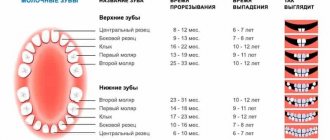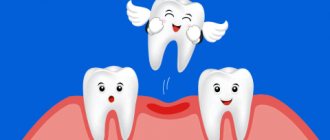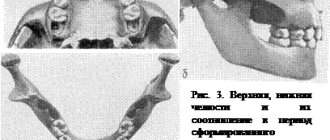In children from the age of 5, temporary milk teeth begin to fall out and are gradually replaced by permanent ones, which will serve for the rest of their lives. Many parents are interested in the question: how many teeth change in childhood? All baby teeth fall in, and permanent teeth grow in their place. They change in the same order as during teething. But parents should know that at the age of 6-7, the baby begins to grow his first permanent molars (sixth teeth) - they are the ones that remain for life. Children's fifth molars are the last to fall out and are replaced with permanent molars. Teeth are completely replaced by about 12-14 years, but it all depends on the individual characteristics of the body and various other factors.
Often, during tooth replacement, some non-standard situations and features can be observed, because of which parents begin to worry. Let's take a brief look at the most common questions:
What reactions of a child’s body are possible during the period of loss of baby teeth and growth of permanent teeth?
Replacing teeth is almost painless. The loss of baby teeth occurs on their own after their root is completely absorbed or removed at home, and if the permanent tooth is already growing, but the permanent one has not yet fallen out, the help of a pediatric dentist is required. When permanent teeth erupt, pain usually does not occur. Very rarely, there may be a slight increase in body temperature, itching of the gums or discomfort in the abdomen. In this case, the child does not need treatment, but it is recommended to visit a dentist.
Recommendations
- Pay special attention to your baby's nutrition. It is very important that his diet contains a sufficient amount of digestible calcium.
- Teach your child to maintain oral hygiene from an early age.
- An orthodontic type pacifier can be used.
- In order for the baby to form a correct bite, it is necessary not to allow him to suck his finger or chew a pencil. In addition, by such actions the child can introduce an infection into the oral cavity.
Now you know what to do if your baby teeth fall out and your molars don’t grow. After reading the article, you realized that the delay in timing can be explained by the individual characteristics of your baby’s body, and not necessarily by a pathological process. Do not forget about the factors that can cause acquired or congenital adentia and try to avoid them. If your baby’s health makes you think about going to the doctor, don’t delay it so as not to cause harm through inaction. Be healthy!
Why can a lot of time pass between the loss of baby teeth and the eruption of permanent teeth?
Most often, the front teeth grow quickly. And canines and baby molars (premolars) can be delayed. After a temporary tooth falls out, it may even take 4-6 months until a permanent tooth erupts in that place. Just expect it and take good oral care. But if this period begins to exceed six months, so as not to worry, it is better to visit a doctor. After examining the child, he will be able to decide whether the permanent tooth needs to be stimulated to grow.
Reasons for delay
- There is not enough calcium in the body. The cause of the shortage was not necessarily the presence of pathology. Perhaps the baby was born prematurely, not having time to receive all the necessary microelements, or the tooth did not advance to the required level, or the mother did not eat well during pregnancy and did not consume foods containing calcium. In case of congenital calcium deficiency, the baby will have pale skin, brittle nails, and slow hair growth. In most cases, it is enough to switch the child to a balanced diet. It is very important that it not only includes foods high in calcium, but also excludes those that interfere with its absorption.
- Past infectious diseases. Perhaps, due to a serious illness, your baby has expended all the strength necessary to build a molar.
- Inflammatory processes in baby teeth, caries. In advanced conditions, the molar tooth germ is damaged. This leads to a delay in the growth of the permanent tooth, and it can also come out incorrectly, with an inclination. And this can lead to the formation of an incorrect bite.
- Impact of mechanical injuries. Perhaps the baby had a jaw injury, which caused the rudiments to shift. Now surgical intervention is needed to correct the situation.
- Adentia or retention.
Edentia
Sometimes the reason why a tooth does not grow is adentia - a disease that can be either congenital or acquired. In the case of congenital pathology, the culprit may be a hereditary factor, as well as smoking or drinking alcohol by the mother during pregnancy. Such a phenomenon as acquired adentia is typical in cases when a molar tooth is removed or when, due to infectious processes in a milk tooth, pathogenic microflora penetrates the molar rudiment and thereby destroys it.
When should you start worrying about delayed growth of molars:
- If in the near future after a baby tooth falls out, your little one doesn’t even have a hint of a permanent tooth, it’s too early to worry. Sometimes it takes a whole year for a molar to appear.
- Of course, there are tables that indicate the approximate timing of the appearance of permanent teeth. However, due to the fact that all children are individual and their physiological characteristics may differ, an error of even one and a half years is acceptable.
- If you are still worried, it is better to see a specialist. He can easily determine whether the baby has edentia. To do this, he will need an x-ray of the child's jaw. In addition, the baby can have a digital photograph taken, which will be less dangerous in terms of radiation exposure and more informative.
What to do if the diagnosis is confirmed? You must understand that this is not a verdict yet. The child will be able to receive special plates with artificial teeth, which will also be responsible for the formation of the correct bite in the baby. It is better not to delay the installation of such a device. You must understand that the baby may begin to have complexes, his bite will form incorrectly, and he will not be able to fully eat food.
Retention
This diagnosis is made when there is a serious delay in the eruption of a permanent tooth. If we are talking about complete retention, then in the picture you can see the presence of a tooth germ. However, for some reason it does not erupt from the gums. As a rule, this phenomenon is caused by the removal of a baby tooth for medical reasons ahead of schedule or by too deep localization of the molar rudiment.
Partial retention may also be diagnosed. In this case, the upper part of the tooth pecks, and the lower part does not come out for a long time.
To be honest, when my son’s teeth were falling out, I didn’t worry at all and didn’t look for information about the age when which molar should erupt. Once, my son had a baby tooth removed ahead of schedule (the tooth could not be treated). The doctor immediately warned that a molar would not appear there any time soon. That's why I wasn't worried. And all the other teeth were quickly replaced by molars, and there was no need to consult a doctor for advice.
Which teeth should an eight-year-old child have?
Every child who has reached the age of eight should normally have the following permanent teeth - 4 lower and 4 upper incisors, sixth molars. Sometimes there may be individual deviations in teething within plus or minus six months.
Why is it necessary to treat caries in childhood if you then have to remove baby teeth with filled roots?
If an empty space forms in the dentition, this contributes to the fact that the remaining milk teeth shift, and along with them, the rudiments of permanent teeth also shift and they begin to grow incorrectly under them - in one place the formation of cracks begins, and in another - the teeth fit alone another. A filled, treated baby tooth will save space for a permanent tooth. Untreated teeth infect the rudiments of permanent teeth with infection, which causes their deformation and even complete absence.
Timing of eruption of molars
The rudiments of teeth begin to form already in the eighth week of intrauterine development; these are the future milk teeth. The rudiments of molars are at 20, their localization in the child’s jaw is much deeper. It is important that not all the teeth that the baby will erupt as he grows up will later fall out; some of them will immediately become permanent.
On average, a baby's first tooth appears at six months of age, and not later than three years - the child already has a mouth full of teeth.
Let's figure out when it's time for molars to erupt:
- At approximately seven years old, the baby will have molars, sixth teeth (in the dental formula), and from the ages of eleven to thirteen – seven teeth (also molars). It should be taken into account that such teeth do not have milk analogues; they simply erupt from scratch, immediately becoming permanent.
The remaining molars will be licked to replace the milk teeth.
- Between six and eight years of age, the central incisors should appear.
- From seven to nine - the lateral incisors will erupt.
- From ten to twelve years of age, the child will develop premolars (the fourth and fifth teeth on the dental formula).
- Between the ages of nine and thirteen, the molars will erupt.
And already in adulthood, wisdom teeth may appear, although not everyone has them, and this is not a particular problem.
Remember that these are only approximate dates and you should not immediately get upset if your child deviates from these indicators. And if you are very worried, it is better to see a dentist so that he can dispel all doubts.
Why can a 7-14 year old child sometimes experience pain when all his teeth are intact?
Yes, this can happen, but in this case the pain occurs not in the tooth itself, but in the jaw, which is growing rapidly at this age. Since permanent teeth are almost twice as large as baby teeth, they need much more space. Therefore, large new teeth can sometimes overlap each other or grow at an angle, getting out of the dentition. As the jaw grows, they align and settle into place. But a qualified specialist can competently assess this situation, as well as the risk of anomalies and developmental defects. That is why in this case you will need to consult an orthodontist.
What are the dangers of premature removal of baby teeth?
Speech disturbances, inhibited bone growth and unnecessary pain are just some of the unpleasant consequences of not properly caring for baby teeth. Some parents mistakenly believe that there is no need to worry about baby teeth if they fall out anyway. Premature loss of primary teeth, that is, 3-4 years before the date of their physiological loss, in adulthood leads to unpleasant consequences - crowding or various types of malocclusion.
Baby teeth have a specific structure and are very susceptible to caries. Their premature loss is most often caused by advanced caries or mechanical injuries. If primary teeth begin to deteriorate, inflammation of the pulp quickly occurs, and then inflammation easily occurs with complications around the periapical tissues or abscesses. In such cases, it is often impossible to perform root canal treatment. All that remains is to remove the baby tooth. The whole process of pain and treatment exposes the baby to many troubles, and it is worth protecting him from this.
At what age should a bite be corrected?
You can start correcting your bite at 4-5 years of age. In this case, the growth of permanent teeth will be even, in the place intended by nature. Therefore, there is no need to carry out subsequent long-term bite correction. In any case, if there is a malocclusion, the problem can be eliminated efficiently and as quickly as possible by contacting a qualified orthodontist as early as possible.
| Teeth | Dairy (temporary) | Permanent | ||
| Jaw | Lower | Upper | Lower | Upper |
| Central incisors | 6-12 months | 8-12 months | 6-7 years | 6-8 years |
| Lateral incisors | 10-16 months | 9-13 months | 7-8 years | 7-8 years |
| Fangs | 17-23 months | 16-22 months | 9-10 years | 11-12 years old |
| First Premolars | — | — | 10-12 years | 10-11 years |
| Second Premolars | — | — | 11-12 years old | 10-12 years |
| First Molars | 14-18 months | 13-19 months | 6-7 years | 6-7 years |
| Second Molars | 23-33 months | 25-33 months | 11-12 years old | 11-13 years old |
Removal of baby teeth in children
It all depends on the number of lost baby teeth, their location in the jaw and how much time is left before the permanent tooth erupts. If it is three or four years, the more likely it is that the permanent tooth will be delayed or will not grow. The hard and compact bone tissue formed above the tooth germ will be difficult for him. The opposite is true when the time to a supposedly permanent dentition is quite short. Then the eruption of the permanent tooth usually occurs earlier than it would have happened naturally.
Premature loss of primary teeth can also interfere with alveolar bone growth. A child who does not have teeth cannot bite properly, and the forces generated during this activity are not transmitted to the bones and muscles, which does not contribute to their proper development.
Losing two baby teeth on one side, such as the fourth and fifth, can lead to other consequences. With such extensive missing teeth, the occlusal forces between teeth that shape and guide the growth of the alveolar bone are compromised. Thus, growth is uneven and is expressed in the vertical layering of bone where there are no teeth.
Premature loss of a molar, that is, the primary five, always leads to an internal (i.e. forward) displacement of the fixed six. This is a common problem that causes the dental arch to shrink. As a result of this phenomenon, there may not be enough space for other molars. Consequently, crowding of teeth occurs, this feature looks unsightly when there is no room for the canine tooth and it grows outside the dental arch or does not grow at all because due to lack of space, it gets stuck in the bone.
Premature loss of incisors and primary canines, that is, the upper front teeth, contributes to poor jaw bone development, which can lead to malocclusion. For example, if the jaw is underdeveloped compared to the lower jaw, an anterior transverse bite will form (the lower front teeth will overlap the upper ones).
Speech problems may occur in children with severely defective primary teeth, especially the front incisors. Such deficiencies do not contribute to the correct position of the tongue on the palate, so there is a possibility of interdental lisp. As a rule, after the removal of a baby tooth, a child needs 1-2 years of visiting a speech therapist or dentist.
Missing teeth and speech defects not only affect health, but also have a psychological aspect: the child may have low self-esteem, be secretive or shy because of his appearance. Children's baby teeth are truly worth caring for. Oral hygiene is equally important at every stage of life.
A child’s front tooth does not grow for a long time: what to do?
Many parents are faced with this problem when the front molar does not grow after the baby tooth falls out. Don't let your baby worry about this. You and your baby should know that the timing of teething is different for everyone. Trust the dentist. If a specialist confirms that there is no pathology, do not panic. In some cases, the cause of slow growth of radical units is a metabolic disorder. In such situations, a pediatrician and detailed diagnostics will help.
Doctors often refer children to get tested for diabetes. Long-term absence of molars requires the intervention of professional doctors; it is better not to self-medicate. After consultation, the pediatrician will, if necessary, refer the child to specialists. Often in such situations, endocrinologists and gastroenterologists help children. Pediatric doctors can accurately determine the factors influencing the fact that a child’s teeth do not grow for a long time and only then prescribe treatment.
An important point is the correct formation of the bite. If the upper or lower front teeth do not grow in for a long time, there is a chance that the bite will be changed. According to statistics, molars are more likely to slow down their growth, not the front teeth. This may be due to both the child’s living conditions and pathological processes during intrauterine development. Central incisors grow quite quickly after the loss of milk units. Please note that canine teeth can begin to grow at approximately 10-12 years of age. As the child grows, it is necessary to regularly take him to the dental office for examination.











